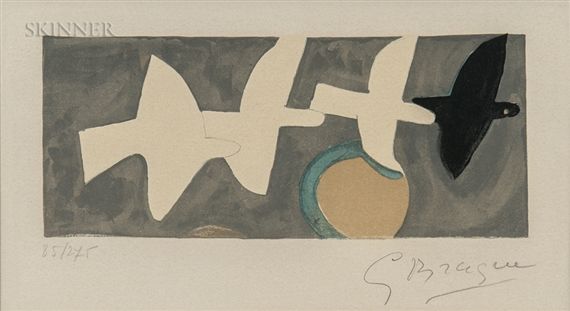No. 3 - George Braque
(1882–1963)
 .
. 
Georges Braque: The Art and Elegance of a Modernist Visionary
Georges Braque (1882–1963) is celebrated as a pivotal figure in modern art, known for co-founding Cubism alongside Pablo Picasso and for pioneering new artistic techniques that continue to inspire generations. But beyond his more famous contributions to painting, Braque also ventured into jewelry design, an endeavor that brought his aesthetic ideals into a completely different, more intimate medium. Here, we’ll explore how Braque’s unique vision manifested through his paintings and his foray into jewelry, shaping his legacy as an artist with a profound sense of depth and elegance.

The Birth of Cubism: A New Approach to Form and Perspective
Braque’s career began as a Fauvist, embracing the vibrant color palette and emotive brushwork that characterized the movement. However, he soon turned toward a more structured style, which led to his groundbreaking partnership with Picasso. Together, they developed Cubism, an avant-garde movement that deconstructed objects into geometric shapes, allowing multiple perspectives to coexist within a single image. This revolutionary approach reshaped the visual language of the 20th century and was a direct challenge to the established traditions of Western art.
In his Analytical Cubist phase, Braque often employed muted colors, focusing on form and structure. This phase is visible in works like Violin and Candlestick (1910), where his intricate and fragmented forms blur the boundary between object and abstraction. Later, during the Synthetic Cubist period, Braque began experimenting with collage, introducing elements like newspaper clippings and painted paper into his compositions, which added textural depth and a new layer of symbolism.
![]()
The Sublime in Braque’s Still Lifes and Landscapes
After World War I, Braque’s style evolved toward a more personal expression that emphasized still lifes and interiors, displaying a quiet elegance that became his hallmark. His works, such as Le Gueridon (1929), often combined muted colors with simplified forms, imbuing everyday objects with a sense of calm and stability. These paintings reveal Braque’s belief in the harmony and balance found within ordinary life, using subdued tones to invite viewers into a reflective, almost meditative state.
Braque’s landscapes, though fewer in number, also demonstrate his understanding of spatial relationships and harmony. The Castle at La Roche-Guyon (1909) exemplifies his innovative use of geometric simplification, where organic forms are rendered in angular shapes. Braque’s landscapes thus act as extensions of his Cubist ideals, offering a geometric yet naturalistic interpretation of nature’s beauty.

Braque and the Art of Jewelry: From Canvas to Adornment
In the final years of his life, Braque extended his artistic genius to jewelry design, marking a fascinating shift from canvas to wearable art. His jewelry pieces, often in collaboration with goldsmith Heger de Löwenfeld, carried over his themes of abstraction and symbolism, blending fine art with fine craftsmanship. These creations, known as the Bijoux de Braque, were inspired by ancient civilizations, particularly Greek mythology, which resonated with Braque's lifelong interest in spirituality and symbolic language.
Braque’s jewelry, characterized by its minimalistic, abstract designs, reflected his artistic philosophy in a new form. Unlike conventional jewelry, the Bijoux de Braque pieces were less about ornamentation and more about storytelling through shapes and motifs. For example, his birds and fish symbols—frequent subjects in his paintings—appeared in his jewelry designs as stylized forms, bridging the realms of sculpture and adornment. These works provided a way for Braque to translate his Cubist ideals into intimate, tangible expressions that individuals could carry with them.

Legacy and Influence
Georges Braque’s contributions to both painting and jewelry continue to inspire artists across disciplines. His paintings expanded our understanding of visual perception, while his jewelry reflected a deeply personal exploration of form and meaning. His work reminds us that true artistry transcends medium, finding new ways to explore beauty and ideas.
Braque’s vision was one of quiet innovation, a nuanced approach that championed restraint, depth, and elegance. Whether on canvas or in gold, his art invites us to see the world from new perspectives, celebrating both the complexity and simplicity of life’s forms. His legacy remains a testament to the enduring power of art to transform, uplift, and inspire.


Shop Braque
More HERE












